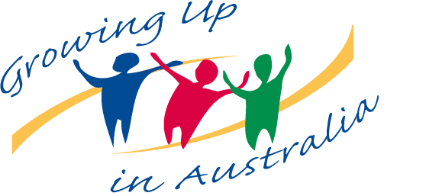General Growing Up in Australia FAQ's
Cannot find what you were after? Please call the Growing Up in Australia team on 1800 005 508 (9am - 5pm AEST) for assistance.
What is a longitudinal study?
A longitudinal study collects information (or data) about the same people repeatedly over a period of time. Longitudinal data helps to create a picture over time and is able to show how actions and events can affect outcomes later in life
Who is running the study?
Growing Up in Australia is funded by the Australian Government and conducted in partnership between the Australian Government Department of Social Services, the Australian Institute of Family Studies and Roy Morgan, with advice provided by a consortium of leading researchers.
What are the areas of interest?
The study aims to examine the impact of Australia's unique social and cultural environment on the next generation and will further understanding of development in early childhood through to adolescence and adulthood.
Growing Up in Australia explores a range of research areas about development and wellbeing of young people and their families including:
|
|
|
Why is the study being conducted?
In 2000–2001, the Government announced its intention to undertake a comprehensive, national longitudinal study of children and their families. Growing Up in Australia is intended to make a major contribution by establishing an up-to-date evidence base for guiding policies that will promote the optimal development and wellbeing of young Australians. The study aims to answer a number of key research questions covering a range of areas such as health and physical development, social and emotional functioning, learning and cognitive development, and emerging adulthood. Read the key research questions [PDF, 571 KB].
Who is in the study?
Participants in the study include the young person (formerly referred to as the 'study child'), their parents (both resident and non-resident), carers and teachers. More detailed information about the study's sample can be found here. Get more detailed information about the study's sample [PDF 350 KB].
How often are the families visited?
Usually, families are visited once every two years, when they are interviewed and direct observations and assessments are conducted. Each biennial data collection is referred to as a 'wave'.
To work with the restrictions imposed by the COVID-19 pandemic in 2020 – 2021, two smaller online surveys were developed for Wave 9 These surveys were administered closer together to allow measurement of similarities and differences in responses as COVID-19 restrictions change over time. This is unique to Wave 9 and we are returning to families in person again for Wave 10, planned for 2023.
How is the data collected?
The modes of data collection have changed over time, and vary depending on the type of respondent. In earlier waves, interviewers conducted both face-to-face and telephone interviews with the study child's parents, and face-to-face interviews with the study child. In 2010, the study children and one of their parents (known as 'Parent 1') also completed part of the interview by entering their responses using a laptop computer. The study child's teacher, carer and other resident parent (known as Parent 2) were asked to complete paper questionnaires. Parents who did not live with the study child were also included in the study and interviewed by telephone.
In Wave 8, the K cohort were aged 18-19 and were the primary respondents. Data were collected from young people in the K cohort using a combination of an online survey, computer survey, and a face-to-face interview. Data was also collected from parents of K cohort young people through a telephone interview.
Due to the COVID-19 pandemic, Wave 9 data collection moved completely online and comprised of two smaller surveys. We are returning to families in person again for Wave 10 in 2023.
Find out more information about the modes of data collection used in each wave for different respondents.
How was the study sample selected?
The sample was selected from the Medicare enrolment database held by the Health Insurance Commission.
The Health Insurance Commission selected children of the appropriate ages and sent an 'invitation to participate' letter to the Medicare cardholder, along with a brochure on Growing Up in Australia. Families had four weeks to register their withdrawal from the study. At the end of this period, remaining families were sent a letter indicating when an interviewer would be in their area. Interviewers subsequently contacted families to arrange an appointment.
How many are taking part?
- B or infant cohort: 5,112 children aged 3-15 months at the start of the study (2004)
- K or child cohort: 4,991 children aged 4-5 years at the start of the study (2004)
How old are the children at each wave of the study?
| Cohorts | Wave 1 (2003-04) |
Wave 2 (2005-06) |
Wave 3 (2007-08) |
Wave 4 (2009-10) |
Wave 5 (2011-12) |
Wave 6 (2013-14) |
Wave 7 (2015-16) |
Wave 8 (2017-18) |
Wave 9C (2020-21) |
Wave 10 (2023) |
|---|---|---|---|---|---|---|---|---|---|---|
| B (infant) | 0-1 years | 2-3 years | 4-5 years | 6-7 years | 8-9 years | 10-11 years | 12-13 years | 14-15 years | 16-18 years | 20-21 years |
| K (child) | 4-5 years | 6-7 years | 8-9 years | 10-11 years | 12-13 years | 14-15 years | 16-17 years | 18-19 years | 20-22 years
|
24-25 years |






